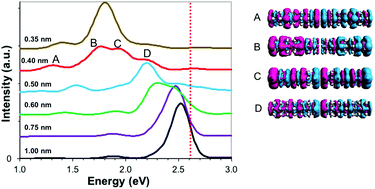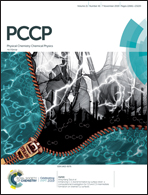Understanding plasmon coupling in nanoparticle dimers using molecular orbitals and configuration interaction†
Abstract
We perform a theoretical investigation of the electronic structure and optical properties of atomic nanowire and nanorod dimers using DFT and TDDFT. In both systems at separation distances larger than 0.75 nm, optical spectra show a single feature that resembles the bonding dipole plasmon (BDP) mode. A configuration interaction (CI) analysis shows that the BDP mode arises from constructive coupling of transitions, whereas the destructive coupling does not produce significant oscillator strength for such separation distances. At shorter separation distances, both constructive and destructive coupling produce oscillator strength due to wave-function overlap, which results in multiple features in the calculated spectra. Our analysis shows that a charge-transfer plasmon (CTP) mode arises from destructive coupling of transitions, whereas the BDP results from constructive coupling of the same transitions at shorter separation distances. Furthermore, the coupling elements between these transitions are shown to depend heavily on the amount of exact Hartree–Fock exchange (HFX) in the functional, which affects the splitting of CTP and BDP modes. With 50% HFX or more, the CTP and BDP modes mainly merge into a single feature in the spectra. These findings suggest that the effects of exact exchange must be assessed during the prediction of CTP modes in plasmonic systems.



 Please wait while we load your content...
Please wait while we load your content...
